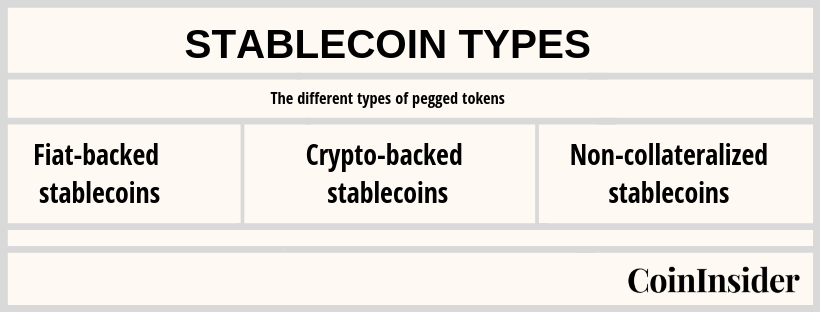Top Five Crypto Red Flags on Social Media
Some scams are easy to see, but others might look like a worthwhile investment opportunity. Here are some crypto red flags to look out for.

Stablecoins in cryptocurrency seem to hold the key to bridge the gap between the benefits of cryptocurrencies and the somewhat more stable nature that fiat currencies offer. The security of a non-volatile digital tender which is both backed up by a national currency and by blockchain sounds like a deal that cannot go ignored. So how do stablecoins work? What are the types of stablecoins? And what’s the catch?
Simply put, a stablecoin in cryptocurrency is a token which has its value pegged to the price of a national currency in order to combat its volatility. There are several types of stablecoins and numerous options and different projects which offer the same fundamental idea of a cryptocurrency coin which has more stability than Bitcoin or altcoins.
There are three types of stablecoins, namely:

These are the cryptocurrencies which are pegged to a national currency, such as Tether which is pegged 1:1 to the US Dollar. This is the easiest way that a stablecoin can be developed. As the name implies, fiat currency needs to be deposited as collateral for a fiat-collateralized stablecoin to exist. From there, the tokens are issued at the 1:1 ratio against the collateralized fiat currency.
This is a simple method but needs regular auditing and a financial custodian to oversee that the token remains fully collateralized – which presents a disadvantage of the token being centralized by a party.
In the same way that a fiat-collateralized stablecoin has fiat tender as collateral, a crypto-collateralized stablecoin has cryptocurrency locked up as collateral, such as Ethereum.
In order to compensate for the volatility of the collateralized cryptocurrency, a security pledge is required by the stablecoin. This means that the coin will not have a 1:1 ratio towards the collateral crypto; it will look more like a $2 USD pledge for every $1 USD stablecoin issued.
There are stablecoins which make use of a Seigniorage Shares system. Seigniorage is the difference between the value of money and the cost of printing it. nNon-collateralized stablecoins rely on a mechanical algorithm which changes the supply volume as needs be in order to maintain their price.
Through the use of smart contracts, the stablecoin will sell if the price falls below and pegged currency and will supply more tokens to the market if the value rises above the pegged currency.
With all this in mind, you might be asking are the best stablecoins.
While we can’t answer that for both legal and subjective reasons – we can offer a list of the best-known stablecoins. There are numerous stablecoins in circulation, so we’re narrowing this down to the top six related to popularity and trading volume.
Tether is arguably the most well-known stablecoin in today’s cryptocurrency market. ‘Tethered’ to a ratio of 1:1 to the US Dollar, Tether stands as one of the most successful stablecoins to see adoption from cryptocurrency exchanges looking to use the token as the go-to currency when direct USD transactions are not possible. This could owe to factors such as country regulations.
One of Tether’s key benefits is that it maintains its $1 USD value and investors and traders can take advantage of this to avoid paying exchange fees and transaction costs.
Although Tether has advantages, such as offering a token which has absolute stability with the US Dollar ratio, the stablecoin has also attracted negative attention from critics related to the centralization of the token, the transparency, and the unfulfilled promise of an official audit.
While Tether might have the badge of honour as the first stablecoin to make its mark, TrueUSD is a fiat-collateralized cryptocurrency which has gained more trust from critics. The stablecoin has managed to gain a reputation for transparency through regular audits, fully backed collateral, and fulfilled legal requirements for the USD-peg.
TrueUSD holds partnerships with numerous banks and trusts in order to steer away from the centralization status that Tether has. Owing to smart contracts in place, TrueUSD has no method of accessing the funds – ensuring complete decentralization.
MakerDAO aims to utilise the native Maker tokens and the Ethereum blockchain in order to minimize price volatility. In order to collateralize the stablecoin, MakerDAO leverages Ethereum using a smart contract and the Ether collateral gathers into something called a Pooled Ether (PETH), which allows the smart contract to generate MakerDAO’s DAI token and interest over time. The interest gained is called the “stability fee” which means that users will need to pay back the same amount of DAI if they want to withdraw Ether from the contract.
The ultimate goal of Basis is to project the token to an index-offering, wherein Basis will aim to ensure its stability by pegging its value to a multitude of assets. Further to this, the project is hoping to leverage two other currencies in a bid to maintain its supply. Token holders can sell their tokens for bonds to gather interest over time on their investment, and Basecoin Shares are issued when the stablecoin’s supply must be expanded.
Cryptocurrency exchange tokens are developed and exist to serve their supporting cryptocurrency exchange. There are exchange-driven stablecoins such as the Gemini Dollar which offer Gemini users reduced fees when trading with the exchange’s native token while ensuring that the Gemini Dollar is pegged at a 1:1 USD ratio.
There have been arguments made both for and against stablecoins.
Advocates for stablecoins have argued that these tokens act as a perfect model in order to fulfil the key elements of what makes up a currency. This means they offer a medium of exchange, a store of value and a unit of account. Furthermore, stablecoins offer the benefits of the blockchain-based tender while avoiding the inherent volatility of cryptocurrencies.
In this case, stablecoins could be the next step towards widespread adoption, which is ultimately beneficial for the cryptocurrency industry.
On the other hand, others have argued that currencies such as the US Dollar are not good collateral owing to their own inflationary nature. Because of this, stablecoins are not a sustainable solution to the very same problem at Bitcoin is trying to solve. In addition, it could be said that because the fiat-pegged ratio is so blatantly derived from a national tender, the stablecoins very well be governed by the nation’s legal financial laws.
Where a person can buy a stablecoin depends on which stablecoin they want to buy and in which area they live. The New-York based exchange Gemini would be the best bet, of course, to buy Gemini tokens. The first step would be to decide whether you want a fiat-collateralized, crypto-collateralized, or non-collateralized stablecoin and then choose which token is most tailored for your trading needs.
Some scams are easy to see, but others might look like a worthwhile investment opportunity. Here are some crypto red flags to look out for.
Find out the countries where you'll pay the most tax if you're trading, holding, buying or selling cryptocurrencies.
Advancements in artificial intelligence and communication technologies make it difficult to discern what's real and what's a scam.
After Kate Middleton's alleged data incident and possible internal attack at the London Clinic, there's a clear need for security in cyber...